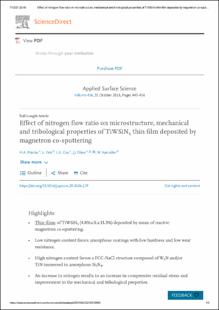Mostrar el registro sencillo del ítem
Effect of nitrogen flow ratio on microstructure, mechanical and tribological properties of TiWSiN x thin film deposited by magnetron co-sputtering
| dc.contributor.author | Olaya, Jhon | |
| dc.contributor.author | Macias Ramirez, Hugo Alejandro | |
| dc.contributor.author | Aperador Chaparro, William Arnulfo | |
| dc.contributor.author | Yate, L | |
| dc.contributor.author | L.E, Coy | |
| dc.date.accessioned | 2021-12-07T21:56:42Z | |
| dc.date.available | 2021-12-07T21:56:42Z | |
| dc.date.issued | 2018-10-31 | |
| dc.identifier.uri | http://repositorio.ufps.edu.co/handle/ufps/1734 | |
| dc.description.abstract | We investigate the deposition of TiWSiNx thin films by means of the method of reactive magnetron co-sputtering, setting the nitrogen flow ratios N2/(Ar + N2) at 4.8%, 9.1%,16.7 and 33.3%. The crystallographic structure of the films was established through X-ray diffraction (XRD), the morphology and topography were evaluated through scanning electron microscopy (SEM) and atomic force microscopy (AFM), the chemical composition was evaluated through X-ray diffraction and X-ray photoelectron spectroscopy, the mechanical properties were evaluated by nanoindentation, and the wear resistance was studied via nanowear and pin-on-disk. It was found that films deposited between 4.8% and 16.7% nitrogen flow ratio exhibited an amorphous phase. As the nitrogen was increased, the films evolved into a mixture of amorphous Si3N4 and crystalline TiWN phase. Moreover, the film morphology changed to fine columnar as the nitrogen flow ratio increased. As a general observation, the hardness, resistance to plastic deformation (H3/E2), and residual stress of the samples increased as the nitrogen flow ratio increased. The maximum hardness, resistance to plastic deformation, and residual stress were 22 ± 0.4 GPa, 213 ± 20 MPa, and 1.4 ± 0.01, respectively. The lowest nanowear volume (0.47 µm3) and wear rate (11 ± 8 10−9 mm3/N mm) were obtained for films deposited at high nitrogen flow ratios. The lowest friction coefficient (0.15) was recorded for films deposited at 16.7% nitrogen flow ratio. | eng |
| dc.format.mimetype | application/pdf | spa |
| dc.language.iso | eng | spa |
| dc.publisher | Applied Surface Science | spa |
| dc.relation.ispartof | Applied Surface Science | |
| dc.rights | © 2018 Elsevier B.V. All rights reserved | eng |
| dc.source | https://www.sciencedirect.com/science/article/abs/pii/S0169433218316969 | spa |
| dc.title | Effect of nitrogen flow ratio on microstructure, mechanical and tribological properties of TiWSiN x thin film deposited by magnetron co-sputtering | eng |
| dc.type | Artículo de revista | spa |
| dc.identifier.doi | https://doi.org/10.1016/j.apsusc.2018.06.129 | |
| dc.publisher.place | Bogota , Colombia | spa |
| dc.relation.citationedition | Vol.456 (2018) | spa |
| dc.relation.citationendpage | 456 | spa |
| dc.relation.citationstartpage | 445 | spa |
| dc.relation.citationvolume | 456 | spa |
| dc.relation.cites | Macías, H. A., Yate, L., Coy, L. E., Olaya, J. J., & Aperador, W. (2018). Effect of nitrogen flow ratio on microstructure, mechanical and tribological properties of TiWSiNx thin film deposited by magnetron co-sputtering. Applied Surface Science, 456, 445-456. | |
| dc.relation.ispartofjournal | Applied Surface Science | spa |
| dc.rights.accessrights | info:eu-repo/semantics/restrictedAccess | spa |
| dc.subject.proposal | Co-sputtering | eng |
| dc.subject.proposal | Mechanical properties | eng |
| dc.subject.proposal | TiWSiNx films | eng |
| dc.subject.proposal | Wear | eng |
| dc.type.coar | http://purl.org/coar/resource_type/c_6501 | spa |
| dc.type.content | Text | spa |
| dc.type.driver | info:eu-repo/semantics/article | spa |
| dc.type.redcol | http://purl.org/redcol/resource_type/ART | spa |
| oaire.accessrights | http://purl.org/coar/access_right/c_14cb | spa |
| oaire.version | http://purl.org/coar/version/c_970fb48d4fbd8a85 | spa |
| dc.type.version | info:eu-repo/semantics/publishedVersion | spa |










